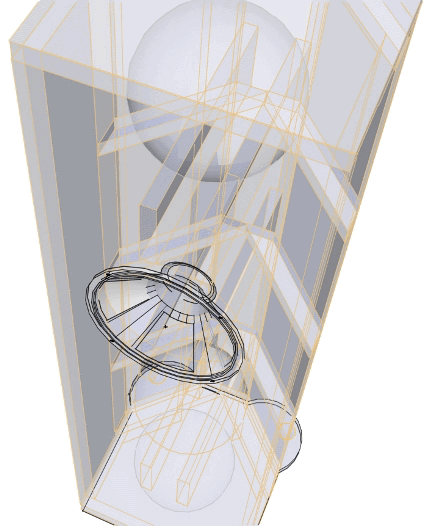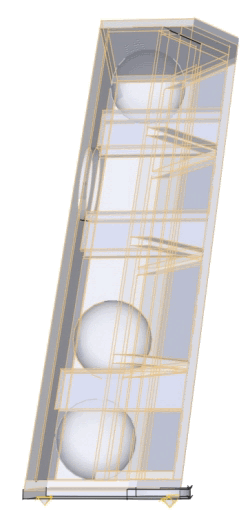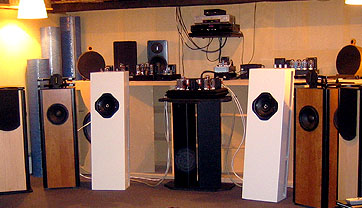|

NFX
Full Range
Single Driver Loudspeaker Design
by
Steve
Deckert
JULY
2006 / updated JULY 2007

NFX
transparent
front view
|
The
NFX is a cabinet design that was specifically created
to deal with destructive rear waves from low-mass full-range
drivers. Lowther, Fostex, and similar 8 inch
full range drivers all share one thing in common - a
super thin cone.
Any
sound inside a typical cabinet will reflect back through the
speaker cone and be heard at nearly the same volume as the
sound coming from the front of the speaker. This makes
designing cabinets for these types of drivers far more
difficult than it would for say your classic 87dB hi-fi woofers.
The rear wave chaos that happens inside most reflex
cabinets and horn designs is what causes the infamous
"midrange shout" that these drivers are incorrectly
known for.
Imagine
a design where the cabinet acts like a check valve allowing
the rear wave to completely exit the cabinet before
the next wave appears. To pull this little
trick off, the NFX cabinet is carefully shaped and features
two vertical ducts that run from top to bottom on either
side of the cabinet.
The
NFX design is similar to what used to be known as an
"Ultra-Flex" cabinet which was popular in
the 1950's. An ultra-flex as it were is similar
to a ported cabinet but large ducts are used rather
than port tubes. The ducts typically run the entire
dimension of the cabinet on both sides. Naturally
the mach speed of these ducts is far lower than a port
tube so there is virtually no port noise.
Another
advantage to these large ducts is symmetrical loading
of the cabinet with an instantaneous release of pressure.
Where this variation of the ultraflex differs
is in the cut rear corners and of course the 8 degree
angle that the entire cabinet is raked back at. These
two things eliminate many of the parallel surfaces inside
the box. The parallel surfaces that remain are busted
by foam spheres.
Additionally,
the 45 degree angled back also causes the ducts to be
at an angle facing into the listening space. Since
the sound output of these ducts are driven by both duct
resonance and the midrange energy inside the cabinet
their output is significant to frame the output from
the front of the speaker. This in turn widens
the dispersion of the front driver giving the sensation
of great height and width normally not found in single
driver designs.
 The
lower frequencies are evacuated through the ducts at
each cycle rather than standing inside the cabinet.
At the turn over frequency where the wavelengths
are not long enough to bend through the ducts, reflection
begins to occur as it does in all cabinets. This
problem has been solved by installing 7 inch diameter
poly foam spheres inside the cabinet stacked from the
bottom to the top. These act like a wave
guide for lower midrange frequencies and help to absorb high frequencies
that otherwise could reach the
back of the speaker cone. The
lower frequencies are evacuated through the ducts at
each cycle rather than standing inside the cabinet.
At the turn over frequency where the wavelengths
are not long enough to bend through the ducts, reflection
begins to occur as it does in all cabinets. This
problem has been solved by installing 7 inch diameter
poly foam spheres inside the cabinet stacked from the
bottom to the top. These act like a wave
guide for lower midrange frequencies and help to absorb high frequencies
that otherwise could reach the
back of the speaker cone.

THE
SOUND:
The
closest thing you can compare the sound to would be an open baffle,
but without the drawbacks. Unlike the open baffle, the NFX
rear wave is redirected back to the front. This makes it easier
to set up in a given listening room making the distance from the front
wall less critical. Also open baffles are typically into
cancellation of bass frequencies at 100Hz or higher so they often
lack any real weight unless another low frequency driver is used.
The large size of an open baffle makes it a huge reflector that
is angled directly at the listener sending all the room reflections
it collects to the listener - usually bad for image focus.
With
the NFX you get an open sound similar to an open baffle, but an
entire octave more bass. The speaker does not sound thin and
can be enjoyed without the addition of a low frequency driver. If
a sub is used to extend the response it should be crossed over around
50 Hz.
|
We
challenge you to take any 8 inch full range driver and compare the
NFX cabinet to any ported box, or folded horn design. Hearing the
NFX cabinet side by side will make either of the other two designs
sound congested in the midrange.
There
will be those who own single driver full range cabinets who are
fully satisfied that their speakers do not sound congested, I was
one of them. Like everything, it's your point of reference.
Hearing these cabinets next to my previous reference speaker
made it sound congested for the first time, so much so that I had
to modify the design significantly just to get it listenable next
to the NFX.
When
you hear stories about these full range drivers taking forever to
break in, at least 200 hours or more - lots more... before they
sound good - try this experiment: Take your well broken in
driver in your favorite cabinet and purchase a brand new driver
and place it in the NFX cabinet. Compare the two speakers
side by side. The brand new driver in the NFX cabinet will
appear to sound more broke-in than the seasoned driver does in the
other cabinet. That also happened to me, and that's the kind
of difference a cabinet can make folks. It may not be easy
to build but the results more than justifies the cost or effort of
this esoteric cabinet design.
BUILDING
THE NFX cabinet
 The NFX are
not pricey cabinets to build from a material standpoint, however
they will test even the most experienced craftsman. Be prepared
to cut most of the boards wrong at least once. The reason
for the difficulty is the 8 degree angle of the cabinet. Everything
that would normally be straight cuts down to every last brace has
been skewed by 8 degrees. Also this skewing creates a compound
angle at the rear of the cabinet where the panels are at 45 degrees. The NFX are
not pricey cabinets to build from a material standpoint, however
they will test even the most experienced craftsman. Be prepared
to cut most of the boards wrong at least once. The reason
for the difficulty is the 8 degree angle of the cabinet. Everything
that would normally be straight cuts down to every last brace has
been skewed by 8 degrees. Also this skewing creates a compound
angle at the rear of the cabinet where the panels are at 45 degrees.
No doubt someone
will wonder if they can build it without the 8 degree skew and then
just lean the cabinet back 8 degrees after it's finished. This
will work but the sound and appearance will be lacking compared
to the building it the proper way.
Be sure to
keep the right and left panels marked, and dry fit the entire cabinet
before gluing. Material can be your choice of MDF or Birch
cabinet grade plywood.
DRIVER
SELECTION
We recommended
the DFR-8 Decware Full Range driver for best results, but you may
also use drivers like a stock FE206E Fostex driver, the Audio
Nirvana 8 inch driver, Most of the Lowther's will also fair well
in this cabinet.

FOAM SPEARS
If
you want to build your own from the plans, you'll need to get the
correct foam spheres to put inside the cabinet. The foam balls
(up to 4 per cabinet) can be found at www.poof-slinky.com
These
are 7 inch foam balls.
| Below
is a picture of NFX cabinets done in a white high
gloss finish.

|
Plans
are available for instant download for $10
Get
a redemption number (also known as a password)
to access plans below
NFX
CABINET PLANS
(in .pdf format - requires Acrobat Reader
to view and print)
NFX2007.pdf
is a 36 page highly illustrated document. File size is 2 megs.
NOTE:
Your user name at is the word " private
" in all lower case.
Your redemption number
is the password.
We
also offer this speaker completely finished here.
|

 The
lower frequencies are evacuated through the ducts at
each cycle rather than standing inside the cabinet.
At the turn over frequency where the wavelengths
are not long enough to bend through the ducts, reflection
begins to occur as it does in all cabinets. This
problem has been solved by installing 7 inch diameter
poly foam spheres inside the cabinet stacked from the
bottom to the top. These act like a wave
guide for lower midrange frequencies and help to absorb high frequencies
that otherwise could reach the
back of the speaker cone.
The
lower frequencies are evacuated through the ducts at
each cycle rather than standing inside the cabinet.
At the turn over frequency where the wavelengths
are not long enough to bend through the ducts, reflection
begins to occur as it does in all cabinets. This
problem has been solved by installing 7 inch diameter
poly foam spheres inside the cabinet stacked from the
bottom to the top. These act like a wave
guide for lower midrange frequencies and help to absorb high frequencies
that otherwise could reach the
back of the speaker cone. 
 The NFX are
not pricey cabinets to build from a material standpoint, however
they will test even the most experienced craftsman. Be prepared
to cut most of the boards wrong at least once. The reason
for the difficulty is the 8 degree angle of the cabinet. Everything
that would normally be straight cuts down to every last brace has
been skewed by 8 degrees. Also this skewing creates a compound
angle at the rear of the cabinet where the panels are at 45 degrees.
The NFX are
not pricey cabinets to build from a material standpoint, however
they will test even the most experienced craftsman. Be prepared
to cut most of the boards wrong at least once. The reason
for the difficulty is the 8 degree angle of the cabinet. Everything
that would normally be straight cuts down to every last brace has
been skewed by 8 degrees. Also this skewing creates a compound
angle at the rear of the cabinet where the panels are at 45 degrees.